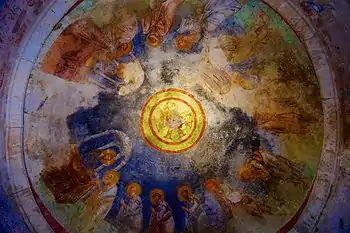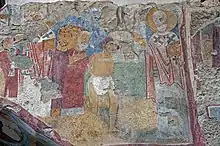St. Nicholas Church, Demre
St. Nicholas Church is an ancient East Roman basilica church in the ancient city of Myra, now a museum located in modern Demre, Antalya Province, Turkey. It was built above the burial place of St Nicholas, a 4th-century Christian bishop of Myra,[1][2] an important religious figure for Eastern Orthodox Christians and Roman Catholics and the historical inspiration for Santa Claus.[3] Its use dated from its 6th century construction for the state church of the Roman Empire by Justinian the Great. The basilica is on UNESCO's tentative list to become a World Heritage Site.[4]

History
The church was built in AD 520 on the foundations of an older Christian church where Saint Nicholas had served as a bishop.[5] Justinian I contributed to the reconstruction.[6] It is noted for its remarkable wall frescos, and its architectural and religious significance.[5]
Over time the church was flooded and filled with silt. In 1862 it was restored by Russian Emperor Nicholas I, who added a tower and made other changes to its Byzantine architecture. The church continued to function until its final abandonment by the Eastern Orthodox Church in 1923, when the remaining Greeks of Demre were required to leave by the Population exchange between Greece and Turkey.
Archaeological excavations
Archaeological excavations in the Church started in 1988 directed by Prof. S. Yıldız Ötüken of Hacettepe University, Ankara, Turkey. The work has revealed some of the northern section of the monastery complex, and also the small chapels around the nave, one of which notably contains vibrant frescoes detailing the life and miracles of the saint, and a desecrated sarcophagus which is thought to be the original burial place from which his remains were forcibly translated to Bari in 1087.[7]
 St. Nicholas Church Exterior
St. Nicholas Church Exterior St. Nicholas Church from courtyard
St. Nicholas Church from courtyard St. Nicholas Church courtyard from high
St. Nicholas Church courtyard from high St. Nicholas Church View to choir
St. Nicholas Church View to choir St. Nicholas Church at choir
St. Nicholas Church at choir St. Nicholas Church view from choir
St. Nicholas Church view from choir
Decoration
The northeast annex arcade contains the only example of St Nicholas's life cycle on ancient frescos in Turkey.[3]
 St. Nicholas Church Fresco
St. Nicholas Church Fresco St. Nicholas Church Fresco
St. Nicholas Church Fresco St. Nicholas Church Fresco
St. Nicholas Church Fresco St. Nicholas Church Fresco
St. Nicholas Church Fresco St. Nicholas Church Fresco
St. Nicholas Church Fresco St. Nicholas Church Fresco
St. Nicholas Church Fresco St. Nicholas Church Fresco
St. Nicholas Church Fresco St. Nicholas Church Fresco
St. Nicholas Church Fresco St. Nicholas Church Fresco
St. Nicholas Church Fresco St. Nicholas Church corridor with Nicolas frescos
St. Nicholas Church corridor with Nicolas frescos
Opus sectile
Parts of the church preserve opus sectile decoration.
 St. Nicholas Church opus sectile
St. Nicholas Church opus sectile St. Nicholas Church opus sectile
St. Nicholas Church opus sectile St. Nicholas Church opus sectile
St. Nicholas Church opus sectile
Liturgy
The Orthodox Liturgy is occasionally celebrated in the church on 6 December.
See also
References
- Domenico, Roy Palmer (2002). The regions of Italy: a reference guide to history and culture. Greenwood Publishing Group. p. 21. ISBN 0-313-30733-4.
Saint Nicholas (Bishop of Myra) replaced Sabino as the patron saint of the city… A Greek from what is now Turkey, he lived in the early fourth century.
- Burman, Edward (1991). Emperor to emperor: Italy before the Renaissance. Constable. p. 126. ISBN 0-09-469490-7.
For although he is the patron saint of Russia, and the model for a northern invention such as Santa Claus, Nicholas of Myra was a Greek.
- "Demre Statues". St. Nicholas Center. Retrieved 17 December 2018.
- "St. Nicholas Church". UNESCO World Heritage Centre. Retrieved 17 December 2018.
- "St. Nicholas Church Myra/Demre". www.stnicholascenter.org. St. Nicholas Center.
- Van Dam, Raymond (2008). Ashbrook Harvey, Susan; Hunter, David G. (eds.). The East (1): Greece and Asia Minor. The Oxford Handbook of Early Christian Studies. Oxford University Press. p. 335. doi:10.1093/oxfordhb/9780199271566.003.0017.
- For the story of the translation of the bones see: Charles W. Jones, "Saint Nikolaos of Myra, Bari, and Manhattan: Biography of a Legend" (Chicago: University of Chicago Press) 1978, ISBN 978-0-226-40700-5, pp. 176-193.